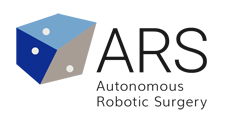ARS Project at the hsmr 2021
Hamlyn Symposium on Medical Robotics 2021
virtual poster presentation at the hsmr21 – April-july 2021
The Hamlyn Symposium on Medical Robotics (#HSMR21) is now in its 13th year and has provided an annual forum for surgeons and engineers from across the globe to network and explore the latest developments in medical robotics.
Data-driven Update of Physics-based Models for Autonomous Robotic Surgery
Tagliabue, E., Dall’Alba, D., Piccinelli, M. & Fiorini, P.
An Autonomous Robotic Surgical System (ARSS) requires the integration of both situation awareness and cognitive skills [1]. It also benefits from the presence of an up-todatesimulation of the surgical scenario, that provides support throughout task execution (e.g. complementing intra-operative sensor data) (Fig.1). The simulation is created with personalized physics-based models. However, such models need updating during the intervention based on real data, to correct for possible inaccurate initial parametrization and guarantee that the simulation continuously represents the current surgical state.
Towards the automatic extraction of procedural knowledge from robotic assisted surgical texts
Bombieri, M., Rospocher, M., Dall’Alba, D., & Fiorini, P.
The automatic extraction of knowledge about intervention execution from surgical manuals would be of the utmost importance to develop expert surgical systems and assistants. In this work we assess the feasibility of automatically identifying the sentences containing procedural information from a written description of a surgical intervention.
A cognitive framework for surgical task automation
Meli, D., Tagliabue, E., Ginesi, M., Roberti, A., Dall’Alba, D. & Fiorini, P.
An Autonomous Robotic Surgical System (ARSS) requires the integration of both situation awareness and cognitive skills [1]. It also benefits from the presence of an up-todatesimulation of the surgical scenario, that provides support throughout task execution (e.g. complementing intra-operative sensor data) (Fig.1). The simulation is created with personalized physics-based models. However, such models need updating during the intervention based on real data, to correct for possible inaccurate initial parametrization and guarantee that the simulation continuously represents the current surgical state.
